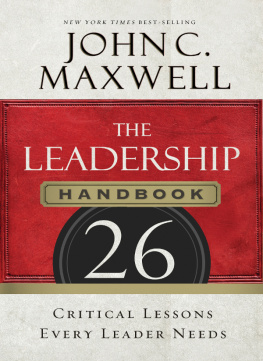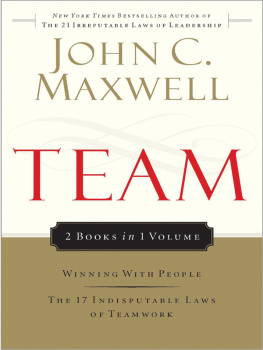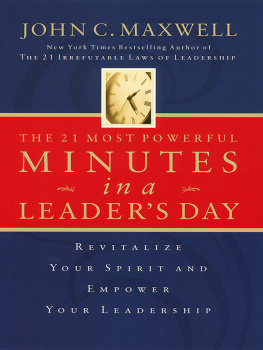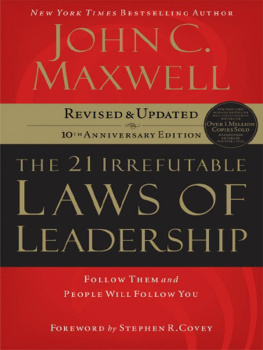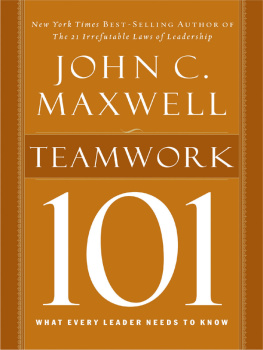
Glue

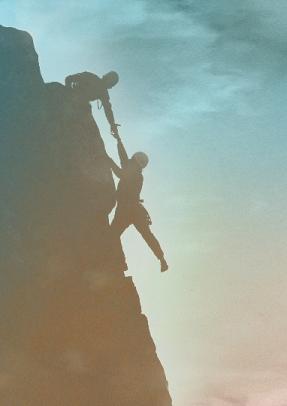
TEAMWORK
MAKES THE
DREAM
WORK
JOHN C. MAXWELL
J. COUNTRYMAN
NASHVILLE, TENNESSEE
WWW.JCOUNTRYMAN.COM
ACKNOWLEDGEMENTS
Grateful permission is made to Thomas Nelson Publishers for permission to reprint from the following books:
Maxwell, John C. 1999.
The 21 Indispensible Qualities of a Leader: Becoming the Person Others Will Want to Follow. Nashville, Tennessee: Thomas Nelson Publishers.
Maxwell, John C. 2001.
The 17 Indisputable Laws of Teamwork: Embrace Them and Empower Your Team. Nashville, Tennessee: Thomas Nelson Publishers.
Maxwell, John C. 1997.
Becoming a Person of Influence.
Nashville, Tennessee: Thomas Nelson Publishers.
Copyright 2002 by Maxwell Motivation, Inc.
Published by J. Countryman, a division of Thomas Nelson, Inc., Nashville, Tennessee 37214
All rights reserved. No portion of this publication may be reproduced, stored in a retrieval system, or transmitted in any form by any meanselectronic, mechanical, photocopying, recording, or any otherexcept for brief quotations in printed reviews, without the prior written permission of the publisher.
J. Countryman is a trademark of Thomas Nelson Inc.
Unless otherwise indicated, all Scripture quotations in this book are from the New King James Version (NKJV) 1979, 1980, 1982, 1992, Thomas Nelson, Inc., Publisher.
Designed by Kirk DouPonce, UDG|DesignWorks, Sisters, Oregon
Project editor: Kathy Baker
ISBN 0-8499-5508-4
Published in association with Sealy M. Yates, Literary Agent, Orange, California.
Printed and bound in Belgium
www.thomasnelson.com
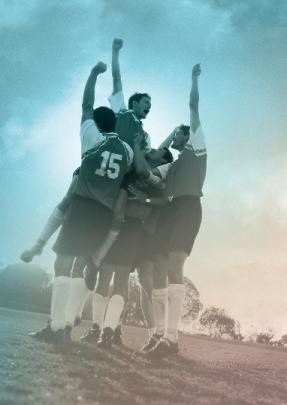
A re you dreaming big enough? That may strike you as a funny question. Dream bigger? you may ask. Im not accomplishing the little goals I have, you may say, and you want me to dream about doing bigger things?
I find that many people are afraid to dream big. They are reluctant to hope for too much because they dont want to be disappointed. As a result, they satisfy themselves with the mundane.
It doesnt have to be that way. Even if you suspect in your heart of hearts that you dont have the talent or resources to accomplish your goalsmuch less accomplish your wildest dreamsyou dont have to give them up. You just need to change your strategy. Instead of working alone, you need to be part of a team. Here is what a team can do for you:
It makes you better than you are.
It multiplies your value to others.
It enables you to do what you do best.
It allows you to help others do their best.
It gives you more time.
It provides you with companionship.
It helps you fulfill the desires of your heart.
It makes everyone on the team a winner.
Teams are incredible things. No task is too great, no accomplishment too grand, no dream too far-fetched for a team. It takes teamwork to make the dream work.

COMING TOGETHER IS A BEGINNING.
KEEPING TOGETHER IS PROGRESS.
WORKING TOGETHER IS SUCCESS.
JOHN C. MAXWELL
Teams come in all shapes and sizes.
If youre married, you and your spouse
are a team. If you are employed by
an organization, you and your colleagues
are a team. If you volunteer your time,
you and your fellow workers are a team.
As Dan Devine joked, A team is a team is a team.
Shakespeare said that many times.
While the great playwright may not have
said exactly that, the concept is nonetheless
true. Every day in some way, you are
a part of a team. The question is not,
Will you participate in something that
involves others? The question is, Will your
involvement with others be successful?
THE 17 INDISPUTABLE LAWS OF TEAMWORK

No problem is insurmountable.
With a little courage,
teamwork, and determination
a person can overcome anything.
B. DODGE
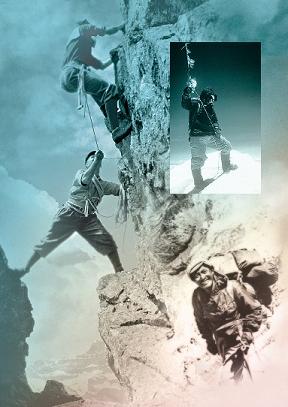
MOUNTAIN TOP EXPERIENCE
I n 1935, twenty-one-year-old Tenzing Norgay made his first trip to Mount Everest. He worked as a porter for a British team of mountaineers. A Sherpa born in the high altitudes of Nepal, Tenzing had been drawn to the mountain from the time that westerners began visiting the area with the dream of climbing to the mountains peak. The first group had come in 1920. Fifteen years later, climbers were still trying to figure out how to conquer the mountain.
The farthest Tenzings first expedition would go was up to the North Col, which was at an altitude of 22,000 feet. (A col is a flat area along a mountains ridge between peaks.) And it was just below that col that the climbing party made a gruesome discovery. They came across a wind-shredded tent, and in that tent was a skeleton with a little frozen skin stretched over the bones. It was sitting in an odd position, with one boot off and the laces of the remaining boot between its bony fingers.
HARSHEST PLACE ON THE PLANET
Mountain climbing is not for the faint of heart because the worlds highest peaks are some of the most inhospitable places on earth. Everest is remote. At 29,035 feet, the altitude incapacitates all but the hardiest and most experienced climbers, and the weather is ruthlessly unforgiving. Experts believe that the bodies of about 120 failed climbers remain on the mountain today.
The body Tenzing and the others found in 1935 was that of Maurice Wilson, an Englishman who had sneaked into Tibet and tried to climb the mountain without the permission of the Tibetan government. Because he was trying to make the ascent quietly, he had hired only three porters to climb the mountain with him. As they approached the North Col, those men had refused to go any farther with him. Wilson decided to try to make the climb on his own. That decision killed him.
Only someone who has climbed a great mountain knows what it takes to make it to the top. For thirty-two years, between 1920 and 1952, seven major expeditions triedand failedto make it to the top of Everest. Tenzing Norgay was on six of those expeditions. His fellow climbers joked that he had a third lung because of his ability to climb tirelessly while carrying heavy loads. During those climbs, he earned everyones respect.
NOT A CASUAL STROLL
In 1953, Tenzing embarked on his seventh expedition to Everest with a British group led by Colonel John Hunt. By then, he was respected not only as a porter who could carry heavy loads at high altitudes, but also as a mountaineer and full-fledged expedition member, an honor unusual for a Sherpa. The year before he had climbed to a height of 28,250 feet with a Swiss team. At that time, it was the closest any human being had come to the top of Everest.
Tenzing was also engaged to be the British groups sirdar for the trip, the Sherpa leader who would hire, organize, and lead the porters for the journey. That was no small task. To get just two people from base camp up to the summit, the team brought ten high-altitude climbers, including a New Zealander named Edmund Hillary. Altogether, the men would require two and a half tons of equipment and food. Those supplies couldnt be trucked or airlifted to the base of the mountain. They would have to be delivered to Kathmandu, then carried on the backs of men and women 180 miles up and down Himalayan ridges and over rivers crossed by narrow rope-and-plank bridges to the base camp. Tenzing would have to hire between two hundred and three hundred people just to get the supplies to the mountain.
Next page

